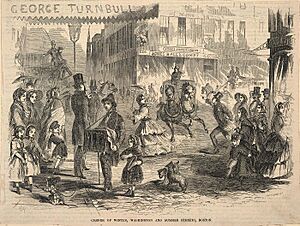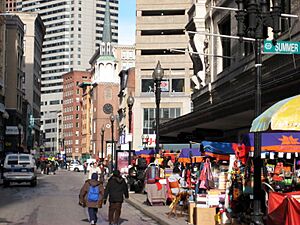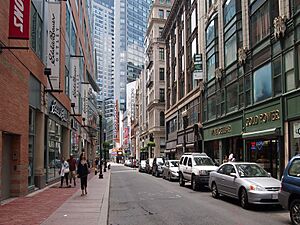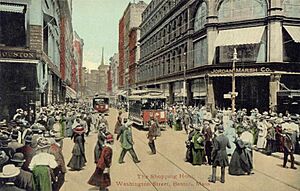Downtown Crossing facts for kids


Downtown Crossing is a busy shopping area in Boston, Massachusetts. It's located right in the heart of downtown. You can find it east of Boston Common, west of the Financial District, and near Government Center and Chinatown.
This area is famous for its big department stores, fun restaurants, and many shops. You'll also see street vendors selling all sorts of things. The Downtown Crossing MBTA station is right in the middle of it all.
The name "Downtown Crossing" comes from where Washington Street meets Winter and Summer Streets. This intersection was once home to two very famous department stores: Jordan Marsh and Filene's. Even though these stores are gone, the area is still a major shopping spot. Many streets around the main intersection are closed to cars, so people can walk freely and safely.
Contents
History of Downtown Crossing
Early Days
In the late 1700s and early 1800s, Summer Street was a very fancy neighborhood. It had beautiful homes designed by famous architects like Charles Bulfinch. But a huge event, the Great Boston Fire of 1872, destroyed much of this area.
The Ladder District
Since the early 1900s, a part of Downtown Crossing has been called the Ladder District. This area is along Washington and Tremont Streets. If you look at a map, the smaller streets connecting these two main roads look like the rungs of a ladder. That's how it got its unique name!
Famous Department Stores
Between 1895 and 1917, Downtown Crossing became the best place to go for department store shopping in Boston.
- Jordan Marsh: This store started in 1841. It was first a wholesale business, selling goods to other shops. Later, it grew into a large retail department store.
- Filene's: Founded in 1881, Filene's was another major store. It became very well-known for its "Automatic Bargain Basement," which opened in 1909. This basement was famous for lowering prices on items the longer they stayed there!
Other stores like Gilchrist and Kennedy's also opened here. These big stores brought many shoppers, including families from the suburbs. They also helped other businesses, like restaurants, grow in the area.
After World War II, downtown department stores faced new challenges. More people moved to the suburbs, and new, larger stores (called big box stores) opened outside the city.
Filene's Basement eventually became a separate store from Filene's. Its main store was actually in the basement of the old Filene's building. The building that housed both stores was added to the National Register of Historic Places in 1986. This means it's an important historical site.
During the Christmas season, Filene's used to have a big Christmas tree lighting ceremony. Jordan Marsh was famous for its "Enchanted Village" window displays. These festive windows showed scenes with animated figures. The Enchanted Village is now displayed at City Hall Plaza.
New Buildings and Changes
After the success of Faneuil Hall Marketplace, Boston decided to make Washington Street a pedestrian-only area. This change happened in 1979. At first, fewer people visited, but slowly, the area became popular again for shopping. A program that allowed street vendors to sell goods helped bring people back.
Today, Downtown Crossing is growing even more. New luxury hotels and apartments are being built. For example, Millennium Place was finished in 2013. These tall buildings are 38 and 36 stories high!
In 1996, the old Jordan Marsh store became Macy's. Then, in 2006, the famous Filene's store closed its doors. The building where Filene's used to be is now being redeveloped.
In 2015, the historic Burnham Building, where Filene's was located, got new tenants. Companies like Havas and Arnold Worldwide moved into the upper floors. Also, a supermarket called Roche Bros. and an Irish clothing store called Primark opened on the ground floor. This brought new life to the area!
Suffolk University's Growth
Suffolk University has also expanded in Downtown Crossing.
- In 2007, the university bought a building on West Street. They turned it into a dormitory for about 270 students.
- In 2010, Suffolk University restored the historic Modern Theatre. They also built a ten-story dormitory right on top of the theater! This building now houses an additional 200 students.
Other Cool Places to See
- First Mint: On the Macy's building, there's a special plaque. It shows where the very first mint in the British colonies was built in 1652 by John Hull. This is where early American coins were made!
- Subway Stations: The Downtown Crossing subway station is right in the district. You can also easily walk to the State Street and Park Street stations. The Silver Line bus service is also available here.
- Shopping Malls: A small mall called Lafayette Place Mall used to be connected to the Jordan Marsh store. It closed in 1992 and is now offices. The Corner Mall, in the old Gilchrist's department store building, now has a large food court and several small shops.
- Boston Irish Famine Memorial: This important memorial is located at the corner of School Street and Washington Street. It remembers the Irish Potato Famine and the many Irish immigrants who came to Boston.



